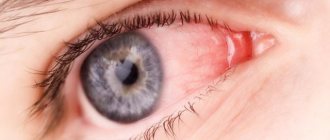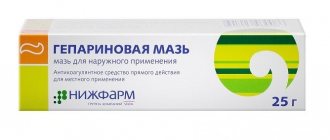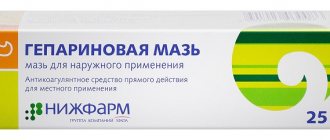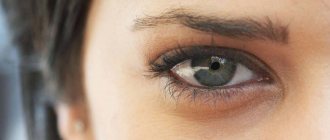It is known where red sclera, dark circles and swelling in the eye area in adults come from. Stressful situations, insomnia, excessive fluid intake shortly before bedtime or kidney problems, for example, are manifested by swelling on the face.
But why do bags appear under a child’s eyes? It is not easy to answer this question. After all, when the baby is very tiny, he is not able to explain to his mother what is bothering him. Relatives are obliged to identify the causes of puffiness, because bags under the eyes sometimes signal serious illnesses.
About the anatomy of the eye
The eye consists of several optical devices at once.
- This is the cornea , which is a transparent membrane that covers the eyeball and blood vessels.
- The anterior chamber is the space that is located between the iris and cornea.
- The iris itself is a circle containing a pupil. This tissue consists entirely of muscles that relax and tense depending on the desire to see a particular object.
- The pupil is the hole in the very center of the iris. Its dimensions correspond to the level of illumination.
- The lens is a natural lens for the eye. This is a transparent elastic fabric that can change its shape, like a camera lens, gradually focusing. Thanks to this opportunity, a person has the happiness of seeing both distant and nearby objects.
- Finally, the retina is a tissue that consists of photoreceptors. She is precisely responsible for the sharpness of the image.
In addition, various metabolic processes occur in the eye due to the presence of vessels in them. The choroid provides blood supply within the structure.
There is also an optic nerve, with which you can receive signals from nerve endings and vice versa, transmit them for processing to the brain.
All organs of vision collectively work as a single mechanism. And any violation can lead not only to deterioration of vision, but also to deterioration of the facial skin tissues that are located around.
Help: Mechanical impact, foreign objects getting into the eyes, retinal dystrophy, myopia - all this can become complications in the form of swelling of the eyes in a child. In children, these processes are most acutely expressed, since the skin is still tender and with any pathological process a similar reaction can occur.
Useful video
Organ of vision. EYE:
Treatment methods
Limiting fluid intake
First of all, in case of swelling, the doctor prescribes limiting fluid intake. When a newborn is breastfed, the child receives the right amount of fluid and it is better not to abuse water. If a baby aged from birth to one year is bottle-fed, the fluid intake per day should be limited to 50 milliliters per kilogram of weight. It should be taken into account that 75% of baby food consists of water.
To calculate how much clean water a child can drink, it is necessary to find the difference between the daily requirement (fifty milliliters multiplied by the child’s weight in kilograms) and the amount of liquid received from food (the amount of formula in milliliters multiplied by 0.75).
When a child turns one year old, solid foods begin to appear in his diet, so his need for water increases. The norm is also calculated based on 50 milliliters per 1 kg of weight.
At three or four years old, a child needs to drink a maximum of 1.3 liters per day. For children seven to eight years old, the volume of liquid consumed is limited to 1.7 liters.
Child nutrition
A balance must be maintained in a child's diet. If puffiness occurs around the eyes, your doctor will usually prescribe a low-salt diet. Salt cannot be completely removed from the menu, since it is necessary for normal metabolism.
Products that need to be removed from children's diets:
- smoked products (cheese, sausage, meat products)
- canned vegetables and marinades;
- semi-finished meat products.
Treatment of conjunctivitis in children
Conjunctivitis occurs due to an allergic reaction or due to the penetration of bacteria into the lining of the eyes. As a result of conjunctivitis, bags form under the eyes. Only an ophthalmologist can make a correct diagnosis. Puffy eyes and red eyelids in a child are an urgent reason to visit a doctor.
The doctor prescribes therapy after identifying the causes of conjunctivitis.
- Conjunctivitis caused by bacteria is treated with antibiotics. The eyes are washed with a solution of furatsilin and sometimes oletethrin ointment is applied.
- Allergic conjunctivitis is fought with the help of hormonal and antihistamines.
- Tetracyclines are used in the treatment of chlamydial conjunctivitis.
We recommend reading other articles on the topic: what to do if a child’s eyes are swollen, why a baby’s eyes are watery, treatment for red eyes.
Treatment of the genitourinary system in children
Mild swelling around the eyes is observed in children during inflammatory processes in the urinary system. The main cause is often cystitis. When diagnosing this disease, doctors prescribe the following medications:
- nitroxoline;
- monural;
- palin
Bags under the eyes also occur with other pathologies of the urinary tract. It is necessary to show the child to a doctor and carry out treatment according to his recommendations.
Treatment of intracranial pressure in children
Sometimes bags appear under the eyes of newborn babies due to increased intracranial pressure. Other signs of ICP in an infant: headache, lethargy, swelling of the fontanel, causeless crying, nervousness, development of strabismus. In this situation, the doctor prescribes:
- sedatives and diuretics;
- massage course;
- physiotherapy;
- classes in the pool;
- vitamin preparations.
With increased ICP, doctors consider long-term breastfeeding important, because mother's milk is not only food for the baby, but also a remedy for many ailments. The period of breastfeeding a baby should last at least six months.
In cases where intracranial pressure is increased due to anatomical disorders, surgical intervention is required in order to restore the outflow of cerebrospinal fluid from the brain.
What is edema
Scientists have come to the conclusion that edema is a phenomenon that is characterized by the accumulation of fluid inside an organ or subcutaneous structure, in tissues or in other spaces of the body.
Edema comes in different forms and can be located in different parts of the human body. There are external and internal swellings. Also, the most common are other classifications that divide edema into local and general.
General
Generalized edema is a broad phenomenon that is characterized by swelling of tissues throughout the human body. This can occur due to diseases of the gastrointestinal tract and heart. It becomes noticeable when a total of more than 3 liters of excess fluid appears in the body. As for the child’s body, edema becomes visible when more than 1 liter of excess fluid appears in the baby’s body.
Eye diseases do not provoke general swelling. However, if the child does not have a functioning gastrointestinal tract, or has kidney or heart disease, then the general swelling that comes from these organs may well also affect the eyes. Therefore, parents will be able to see swelling on the child’s face.
Local
Local edema is a completely different matter. It is attached only to a specific organ or vessel. Most often occurs with lymphatic diseases of blood vessels or veins.
Reference. Local swelling is also possible due to allergies.
With various eye diseases, as well as with mechanical damage, local edema most often manifests itself. It appears only near the site of damage and does not subside until the inflammatory or regenerative process stops.
Physiology or pathology?
Dark circles or “bruises” around the eyes often occur due to the fact that the veins of the periorbital space become wider and darker due to nasal congestion. Children often experience nasal congestion when they have a cold or allergies. Blue under the eyes is sometimes caused by large adenoids. These are lymph nodes located above the tonsils and behind the nose. Children with large adenoids are able to breathe through their mouths and snore loudly.
The second reason is genetics. If parents have this unpleasant defect, most likely their children will also develop bruises. Some people genetically have thinner skin under their eyes. If your baby has fair skin, the veins around the eyes will be more visible, giving a discoloration.
Essentially, dark circles and puffy bags form under the eyes of children for the same physiological reasons as in adults. The skin around the eye is thinner and more transparent than other parts of the face, so it may not completely cover the soft tissue and veins surrounding the eye. For some people, this results in dark circles even in early childhood. Dark circles and bags are sometimes aggravated by fluid retention, so they are more noticeable after eating salty foods. It's clear that lack of sleep causes the blood vessels under the eyes to dilate, while at the same time increasing fluid retention, leading to even more puffy and dark under-eye circles.
Important
When children are getting enough sleep and still have dark circles under their eyes, it may be worth consulting with their pediatrician. In any case, there is no shame in asking your doctor about dark circles in children, just in case, even if there are no serious problems.
Causes of swelling
In fact, swelling has many reasons.
- The most harmless examples of the appearance of edema are after prolonged crying, when the child himself provokes the appearance of such phenomena on his face.
- This often occurs when the mucous membrane of the eye is inflamed, for example, in diseases such as conjunctivitis.
- If a child is allergic, then swelling is quite inherent in this process as one of the symptoms.
- If the child is in the teething stage, then swelling of the face, including the eyes, is also a sign of a similar situation.
Unfortunately, there are also less harmless causes of swelling.
- If a child retains fluid in the body, it begins to systematically accumulate in the tissues. In appearance, parents can understand that their child has gained a little weight and has become visually larger. However, up to a certain point this does not cause any suspicion. Many parents are even happy that the baby is starting to gain weight. However, when swelling appears under the eyes, the situation changes dramatically, and urgent consultation with a doctor is necessary.
- The accumulation of water in tissues due to fluid retention can cause inflammatory processes that occur in the kidneys or in the genitourinary system.
- The doctor will determine that swelling is also observed in other parts of the body.
- If parents are also predisposed to the appearance of swelling under the eyes, then the child may simply inherit this feature. Take a close look at your relatives. If they have bags under their eyes, then their presence in your child is nothing more than heredity.
- If there is swelling of the lower eyelid, then you also need to pay attention to your sleep patterns. Its disturbances, as well as the lack of adequate nutrition or the child’s exposure to fresh air, may also play a role.
- Swelling appears in a baby when he is very tired, or has spent a lot of time looking at a phone or computer screen.
Causes indicating diseases
- Sinusitis
- Conjunctivitis. Its signs are pain, burning in the eyes, itching, watery eyes, red eyelids.
- Allergic reactions to food, plants, insect bites, medications. In this case, there are other manifestations of allergies: itching, redness of the skin, swelling, difficulty breathing, and others.
- Kidney diseases. It is necessary to examine the kidneys if bags appear under the child’s eyes and do not disappear for several days. Rare urination is a signal of improper kidney function.
- Heart failure. With this disease, fluid is retained in the tissues and swelling spreads upward throughout the body, starting from the legs. Dark bags and blue circles around the eyes complete the picture. Heart failure is accompanied by shortness of breath and severe fatigue with light exertion.
- Hormonal disorders. Lethargy, absent-mindedness, dry skin, weight gain, swelling under the eyes indicate that a hormonal imbalance has occurred in the body.
- Increased intracranial pressure.
Severe swelling in children under one year of age
But sometimes parents sound the alarm in vain. For example, when severe swelling is observed before the age of 1 year. The fact is that children at this age lead a mostly sedentary and sedentary lifestyle. As a result of this, the lymph functions poorly, which is why the baby is all slightly swollen. In order to disperse it, parents should more often allow the baby to crawl and play active games, as well as conduct independent massage sessions.
Also, children at this age often cry. As a result, a slight swelling forms under the eyes, which practically does not go away. Notice that after crying it is much more active than before.
However, there are a few more nuances. For example, children mainly eat liquid foods before the age of one year. This means that a large amount of moisture will remain in the body and will not be removed until a certain point.
However, if the swelling on your child’s face is of some unhealthy nature, you see that the color of the swelling is unnatural, and the child is behaving capriciously and not entirely normally, and there are also problems with urination, then you should not hesitate, consult a doctor immediately .
Bags under the eyes in infants
Bags under the eyes in infants do not necessarily occur due to illness. They may appear because the baby cried for a long time, for example, or because the position of the baby’s head in sleep was lower than the body.
It happens that swelling occurs during teething, as well as after an illness. Pediatric doctors believe that in these cases, the periodic appearance of bags under the eyes does not pose a threat.
If eye swelling is not associated with the above reasons and does not go away for a long time, you need to consult a neurologist. Infants may have increased intracranial pressure.
The causes of bags under the eyes are varied, and parents should take steps to eliminate them. The doctor prescribes the correct treatment after examining the child.
Alarming symptoms
When should you go to the doctor? And when a visit to a specialist can be postponed.
If inflammation under the eyes is accompanied by other symptoms that are unusual for the baby’s usual condition, you should immediately consult a doctor. But what symptoms are truly alarming?
- Prolonged runny nose. Most often it is accompanied by a headache and the child will complain about it.
- The child's bags under the eyes have a blue tint.
- The swelling does not decrease throughout the day, but only increases in the evening.
- The child has a heart rhythm disorder.
- The temperature rises.
- The baby complains of pain that occurs when urinating.
- Bloody discharge was found in the urine.
- Swelling is observed not only in the area under the eyes, but also on the face and other extremities.
- The child complains of abdominal or lower back pain.
- Once you have pressed the skin, a small indentation may remain for a while.
Causes not related to diseases
- Inadequate sleep. When a child constantly lacks sleep or, conversely, sleeps for a long time.
- Excess salt and water in the body due to poor nutrition. Swelling caused by this reason appears in the morning and disappears in the evening.
- Load on the visual apparatus. Classes at school after a holiday or excessive use of the computer are a common cause of swelling.
- Genetics. Often, slight swelling in the eye area is inherited genetically and goes away in childhood.
In these cases, swelling from the eyes of children can be removed with a light massage or lotions made from tea or chamomile decoction.
Diagnostics
Important! Do not try to diagnose your child yourself using knowledge from the Internet.
If the swelling becomes unhealthy, be sure to contact your pediatrician. If a child has a fever, it is better to call a specialist at home. When the baby generally feels more or less well, you can come for an examination to a medical institution.
At the initial examination, the pediatrician should suspect problems of the genitourinary system or other inflammatory processes. Therefore, parents will have to collect urine and submit it for analysis. The doctor will also require you to perform a general blood test and an ultrasound of the kidneys and urinary tract.
If the studies do not produce results and according to these points the baby is absolutely healthy, then the doctor should suspect an allergy. Therefore, he will prescribe blood tests and also take allergy tests.
What to do if your baby's eyes are swollen?
If a child’s eyes are swollen, then it is necessary to identify the nature of this manifestation.
If there is a possibility that the baby has an inflammatory, infectious or other disease, then it is better not to self-medicate, but to contact a specialist directly.
However, if the child cried a lot, drank too much liquid, or there was some kind of mechanical damage in the eye area, then parents can relieve the swelling on their own.
What needs to be done for this? To begin with, you can use ordinary folk remedies, which often save you from such cosmetic problems.
- If the bags appear due to lack of sleep, dehydration or a crying child, then you need to reconsider your diet.
- If your child has snot, it is quite possible that the infection has become more severe, so you need to ask the doctor to prescribe another, stronger drug.
- Steep the tea bag for a few minutes. Then cool it slightly to a warm state and apply it in a cooled state to the child’s eyelids.
- Brew chamomile infusion. Before this, one tablespoon of dried flowers should be poured with a glass of boiling water. Let the broth brew for an hour. Then it should be strained and poured into ice trays. Pieces can be used to wipe your child’s eyes in the morning in a playful way.
- In the summer, you can use fresh cucumbers. But they must certainly be freshly grown, without nitrates. Cut the cucumbers into rings and apply to your eyes for several minutes.
- Massage treatments can also have a good effect. To do this, the eye area needs to be massaged well with your fingertips. This is done with very light movements.
Sleep and daily routine
If there are no serious reasons for swelling under the eyes, and doctors have confirmed this, then you need to look for the cause in your daily routine. Edema often occurs in children who do not follow a daily routine. For example, they go to bed late, do not rest during the day, and get up early for kindergarten or school. In such a rhythm, you can not only get swelling under the eyes, but also exhaust your body.
Therefore, children need to establish a sleep and daytime routine.
To start, introduce naps. If the child goes to kindergarten, then naps on weekends or when the baby is at home should coincide in time with sleep in kindergarten.
Lights out must occur no later than 21:00 local time.
The child is picked up for kindergarten or another institution at 7 am.
If the baby sleeps restlessly during the night, the mother may spend a few nights staying close to the baby to calm him down. The baby will understand that there is nothing scary in the dream, and will sleep more soundly.
Important! To improve your child's sleep, ventilate the room a few minutes before going to bed.
Exercise stress
If your child plays any sport, you need to find out from your doctor how safe it is. You may have to reduce your activity or even change your focus.
Additional tips for the future
Dark circles under the eyes may seem like a natural problem, but always remember that prevention is better than cure. Don't wait until your child has dark circles under their eyes. There are ways to avoid the problem in the future:
- Keep your home clean and free from allergens. Help your child prevent allergic reactions by eliminating triggers in the home, especially in his room.
- Maintain a sleep schedule. Make sure your child sleeps 9 to 10 hours every day. Read a book to him to help him fall asleep.
- Offer healthy food options. Your child needs to nourish his body with essential nutrients and stay hydrated at all times.
- Avoid too much sun exposure. The sun's rays reach their peak from 10:00 to 17:00. Do not allow your child to go outside during this time.
Alena Paretskaya, pediatrician, medical columnist
just today
( 59 votes, average: 4.66 out of 5)
How much water can you drink per day during pregnancy?
What tests are taken during pregnancy?
Related Posts
Therapeutic measures
But if swelling has already occurred, you need to consider various ways to get rid of such negative consequences.
How to treat swelling?
Medicines
Depending on the nature of the disease, a certain type of treatment is prescribed.
If there is a viral infection, bacterial, etc., then the doctor may prescribe antibiotics in order to rid the child’s body of such effects as soon as possible.
Also, additionally, if the child has allergies, antihistamines are prescribed.
ethnoscience
There are many traditional medicine recipes that can help get rid of swelling. Let's look at the most common recipes that have received good reviews.
- Firstly, it would be useful to make baths using chamomile or calendula. This method will help relieve inflammation and will also have a positive effect on the child’s appearance. To do this, pour one glass of boiling water over a spoonful of flowers. Wait a few minutes until the broth darkens. Then cool it down. Then everything is quite simple. It is necessary to soak a cotton pad in the flock, and then wipe the inflamed area. It is recommended to carry out the procedure several times. The swelling will subside within a few days.
- Also, you can relieve inflammation if it appears as a result of any infections. Using a decoction of oak bark is also good. It must be brewed according to the directions on the box. The prepared decoction is also used to relieve inflammation.
If you don’t have the above products at home, you can use regular tea bags. Green tea copes well with inflammation. The fewer additives there are in the composition, the better.
Don't forget that there are other ways to relieve inflammation. For example, treating the lower eyelid with ice cubes. It’s good if they are frozen from a herbal decoction. However, if the patient has an infectious disease, then ice therapy should be abandoned.
In order to make an accurate diagnosis, you need to visit a doctor.
Prevention
What measures should parents take to protect their child from such unpleasant situations as edema? Let's talk about this in more detail.
- First of all, parents should establish a sleep schedule for their child. Getting up should be early in the morning, even on weekends. Lights out should occur at approximately the same time at 21:00 pm. However, if the child really wants to spend more time with his parents on the weekend, the child’s stay can be extended until 10:00 pm, but no longer.
- The second no less important point is to instill in the child a love of hygiene. The more often your baby washes his hands, the greater the likelihood that he will never get sick or experience eye problems.
- Teach your child to talk about colds. Some children hide the fact that they are sick, fearing that their parents will treat them with bitter mixtures and other unpleasant drugs. However, it is necessary to instill in the child that the most important thing is health; parents must be informed about poor health immediately.
- Another point that parents need to deal with is nutrition. It is difficult to monitor a teenager's nutrition. However, if we are talking about small children, then parents must adjust their diet so that it is fractional, correct and not dangerous to health.
- Parents should try to avoid contact of children with sick peers. For example, if there is a flu epidemic in the kindergarten, you should not try your luck and take your child to kindergarten. If possible, let him stay with his grandmothers or stay at home with one of his parents. This way, you will reduce the likelihood that your child and other household members will get sick.











